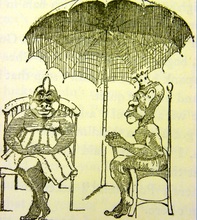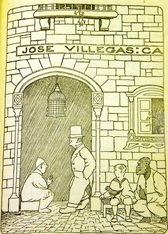Dolittle's Bumpo: A "Bumbling" Archetype of Racism

Winner of the Newberry Medal in 1923, the Newberry being named after 18th century bookseller John Newberry, and given to an author for their contribution to children's literature by the American Library Association, The Voyages of Doctor Dolittle, written and illustrated by Hugh Lofting, has garnered much attention for its use of derogatory terms and depictions of African Americans. Lofting created a series of books which tell the tales of a doctor who can communicate with animals who become his patients as he attempts to better understand nature and history. Included here are images from The Story of Doctor Dolittle and The Voyages of Doctor Dolittle. These books (along with others in this series) are considered, in both their text and illustrations, to be exemplifications of racism. Editions of these works in the United States have been altered since around the 1960's and have been expurgated, or bowdlerized since around 1986, a century after Lofting's birth. Expurgation is the removal (or rewriting or replacing) of anything considered offensive from a work of art; bowdlerization is a related term named after Thomas Bowlder who in 1818 published an expurgated version of a work by Shakespeare. Much of the discourse related to these books involves Prince Bumpo, an African prince, whom, in Lofting's text, is compared to other "negroes" Dolittle has only seen in the circus who "wore feathers and bone necklaces and things like that", and he is one of the main points of expurgation in the "revised" editions. Humor is very often used at Bumpo's expense in the text as he is an English educated man (Oxford schooling) who can't speak "proper" English and says things like "I feel I am about to weep from sediment". In the images here, Bumpo is consistently barefoot, very often not wearing any clothing, and is drawn with exaggerated features such as having a wide nose, big lips, and a large backside. The first two images are from The Story of Doctor Dolittle (1920) and the third is from The Voyages of Doctor Dolittle (1922). Bumpo may have clothing on in the third image, but he is still barefoot and has much more physical expression than his illustrated counterparts. The creation of the name Bumpo is interesting because it is similar to the name of the characters in another story discussed in this website, Little Black Sambo; and it is also interesting as the name can relate to his bumbling and exaggerated speech, and his feet which everyone, including Bumpo himself, apparently trip over.


